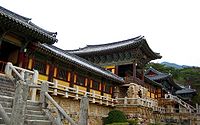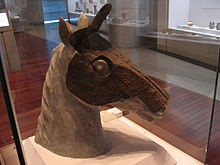- Geumgwan Gaya
-
Geumgwan Gaya Hangul 금관가야 Hanja 金官伽倻 Revised Romanization Geumgwan Gaya McCune–Reischauer Kŭmgwan Kaya History of Korea 
This article is part of a seriesPrehistory Jeulmun period Mumun period Gojoseon ?–108 BCE Wiman Joseon 194 BCE–108 BCE Proto–Three Kingdoms 300–57 BCE Buyeo, Goguryeo, Okjeo, Dongye Jin state, Samhan (Ma, Byeon, Jin) Four Commanderies of Han Three Kingdoms 57 BCE–668 Goguryeo 37 BCE–668 Baekje 18 BCE–660 Silla 57 BCE–935 Gaya 42–562 North and South States 698–926 Unified Silla 668–935 Balhae 698–926 Later Three Kingdoms 892–936 Taebong, Hubaekje, Silla Goryeo Dynasty 918–1392 Joseon Dynasty 1392–1897 Korean Empire 1897–1910 Colonial Korea 1910–1945 Provisional Gov't 1919–1948 Division of Korea 1945–present North, South Korea 1948–present By topic Timeline List of monarchs Linguistic history Science and technology history Art history Military history Naval history
Korea Portal
Geumgwan Gaya (43 - 532), also known as Bon-Gaya (본가야, 本伽倻, "original Gaya") or Garakguk (가락국, "Garak State"), was the ruling city-state of the Gaya confederacy during the Three Kingdoms Period in Korea. It is believed to have been located around the modern-day city of Gimhae, Southern Gyeongsang province, near the mouth of the Nakdong River. Due to its geographic location, this kingdom played a dominant role in the regional affairs from the Byeonhan period onward to the end of the Gaya confederacy.
According to the Samguk Yusa, Geumgwan Kaya was made of 9 villages united by King Suro of Gaya. His wife and queen Heo Hwang-ok, whom he married in 48 AD, is believed to be a princess from the Ayodhya region in what is now India,[1] although this may have been an embellishment made during later Buddhist times.[citation needed]
During this early time in the history of Gaya, several waves of migration from the north, including the earlier-extant Gojoseon, Buyeo, and the Goguryeo, arrived and integrated with existing populations and stimulated cultural and political developments. A sharp break in burial styles is found in archaeological sites dated near the late 3rd century AD, when these migrations are to have taken place. Burial forms associated with North Asian nomadic peoples, such as the burial of horses with the dead, suddenly replace earlier forms in the tombs of the elite (Cheol 2000). In addition, evidence exists indicating that earlier burials were systematically destroyed. In the early 1990s, a royal tomb complex was unearthed in Daeseong-dong, Gimhae, attributed to Geumgwan Gaya but apparently used since Byeonhan times.
After Geumgwan Gaya capitulated to Silla in 532 AD, its royal house was accepted into the Sillan aristocracy (probably because by that time, a major house of Silla, of the Gimhae Kim clan, was related to the Gaya royal house, which was also of the same clan) and given the rank of "true bone," the second-highest level of the Silla bone rank system. General Kim Yu-shin of Silla (also of the Gimhae Kim clan) was a descendant of the last king of Gaya.
See also
- History of Korea
- List of Korean monarchs
- Gaya confederacy
- List of Korea-related topics
References
- ^ "The Relations Between Korea and India: Korean-Indian Relations in Ancient History." http://www.korea.net/news/issue/attach/PDF%20Format_india_2.pdf, page 3 of 9.
- Cheol, S.K. (2000). Relations between Kaya and Wa in the third to fourth centuries AD. Journal of East Asian Archeology 2(3-4), 112-122.
- Il,yeon. Garak-gukgi chronicles, Samgukyusa
Categories:- Gaya confederacy
- Former countries in East Asia
- Former countries in Korean history
- 43 establishments
- 532 disestablishments
Wikimedia Foundation. 2010.




